The Bernina Express train route from Switzerland to Italy is one of the most spectacular train journeys anywhere in the world. Many visitors take the Bernina Express panoramic train, but did you know there’s a cheaper, more flexible alternative? This guide compares the Bernina Express train with the regional red train, with tried-and-tested booking advice and all the pros and cons you need to know when planning your Switzerland trip.
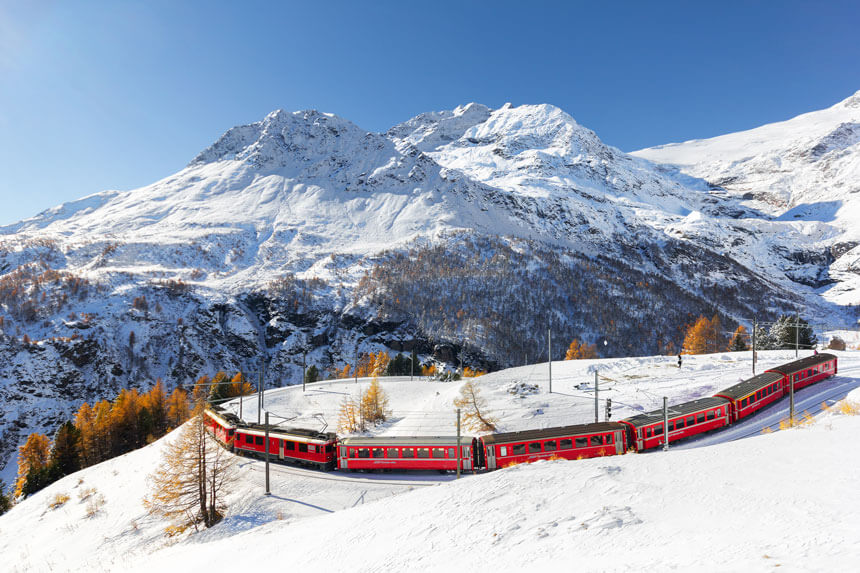
Taking the Bernina Line is a highlight of any trip to Switzerland. The little red train winds its way through forests, meadows, gorges and mountain villages, and alongside waterfalls, lakes and glaciers on its way from Chur in Switzerland to Tirano, just over the border in Italy.
The most famous way to travel on the Bernina line is to take the Bernina Express, a panoramic train aimed at tourists. The Bernina Express travels along the route from either Chur or St Moritz to Tirano. From Tirano, you can either return back the way you came, or, in summer, take a bus from Tirano to Lugano, past Lake Como and Lake Lugano.
For my trip I chose to do something a bit different and take the regional red trains which run along the same route as the Bernina Express. I originally chose the regional trains because I couldn’t get Bernina Express reservations for the dates I wanted, but the normal local services were absolutely brilliant.
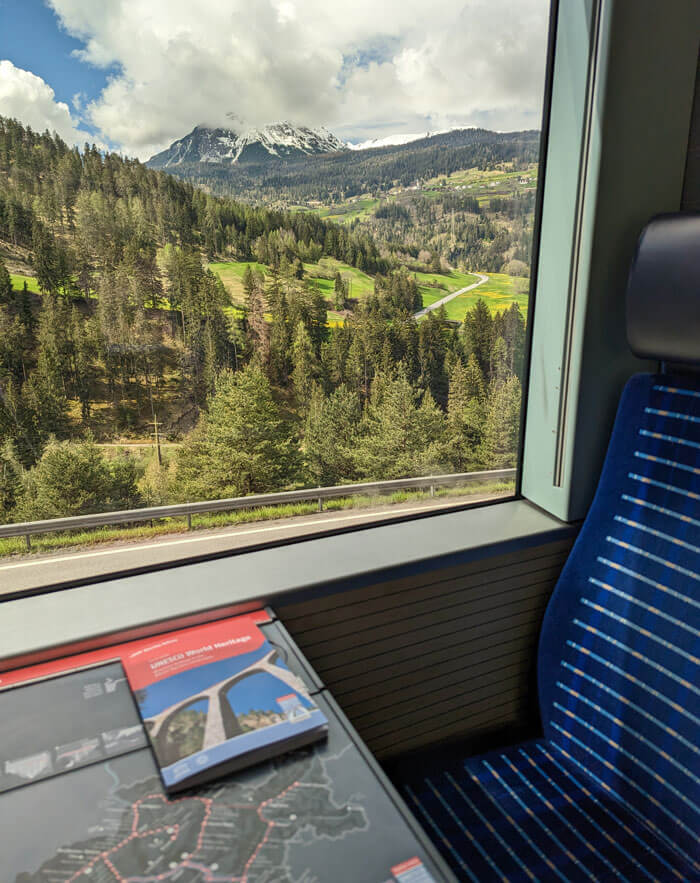
In this post I’ll describe what it’s like to travel from Chur to Tirano on the regional train, and compare some of the pros and cons of taking the Bernina Express vs the regional trains, along with tips for your journey.
Read: Where to stay for the Bernina Express
The Bernina Express route
As well as travelling through amazing landscapes, the Bernina Express route is an astonishing feat of engineering. To climb from the green meadows around Chur up to the Bernina Pass and on to Italy, the train travels through 55 tunnels and across 196 bridges.
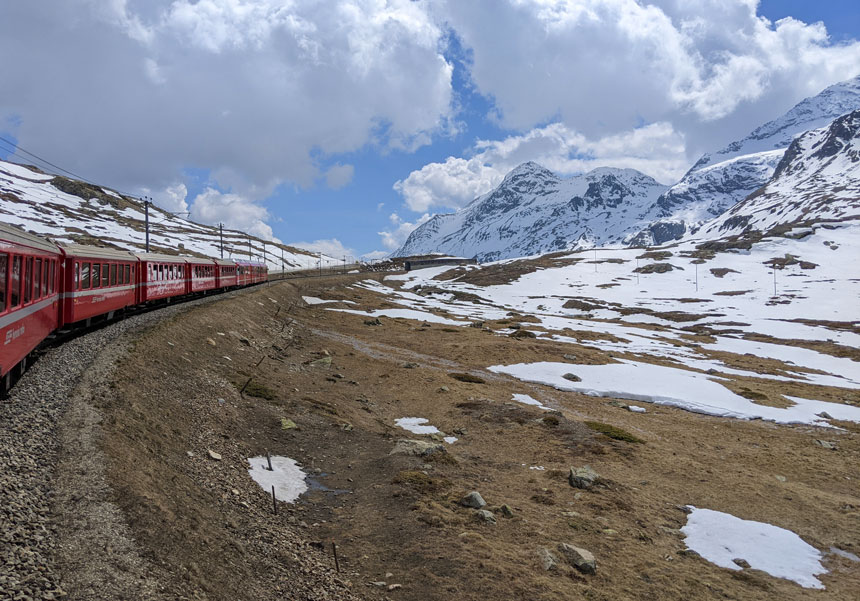
Tunnels twist and loop back on themselves through the mountains, while viaducts stretch across Alpine ravines. It’s an unforgettable journey and an absolute must for a trip to Switzerland or northern Italy.
The full Bernina Express route from Chur to Tirano actually covers two famous lines, the Albula Line and the Bernina Line. The two lines together are a UNESCO World Heritage site.
The Albula Line
The Albula Line links Thusis with St Moritz, but most travellers will start their journey in Chur, a few stops further up the line. The Albula Line includes one of the Bernina Express’s most famous sights, the Landwasser Viaduct, which curves across a deep valley before the tracks plunge immediately into a tunnel.
As well as being on the Bernina Express route, the Albula Line is also on one of the other famous train routes through Switzerland, the Glacier Express.
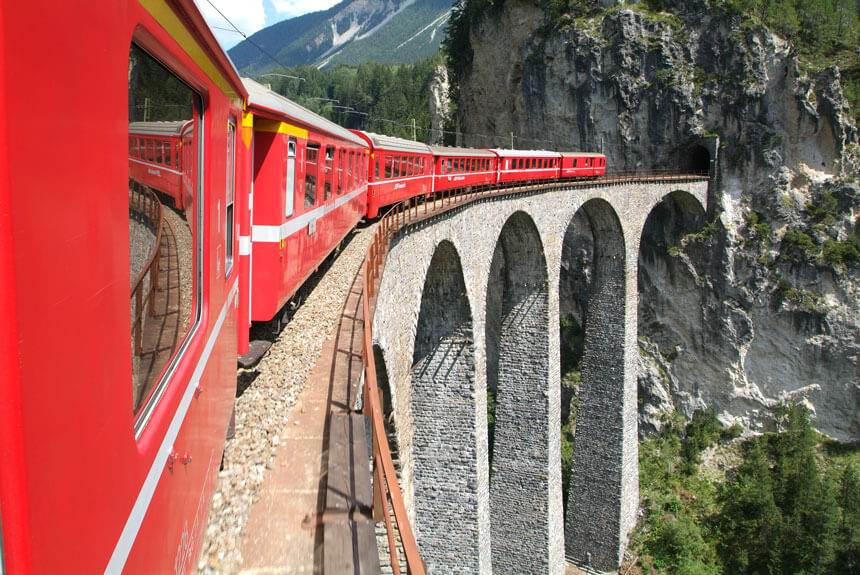
Facts about the Albula Line
- 42 miles long
- Opened between 1896 and 1908
- Lowest point is 584m above sea level at Chur
- Highest point is 1823m at the Albula Tunnel
- 39 tunnels
- 144 bridges and viaducts
The Bernina Line
The Bernina Line runs from St Moritz in Switzerland, over the Bernina Pass, 2,253 metres (7,392 ft) up in the Alps.
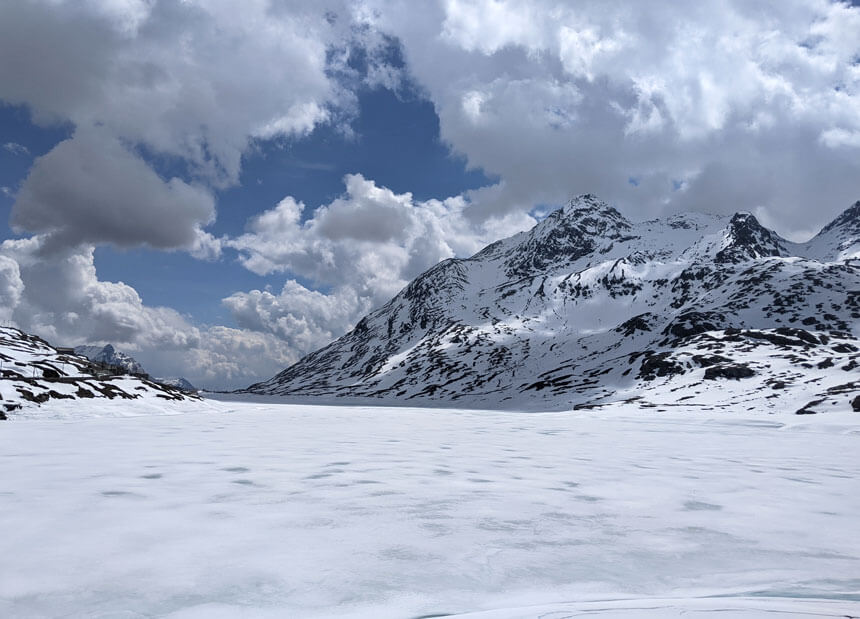
The route continues through Val Poschiavo along the shore of the Lago di Poschiavo and across the Brusio spiral viaduct before crossing the Swiss/Italian border just north of Tirano.
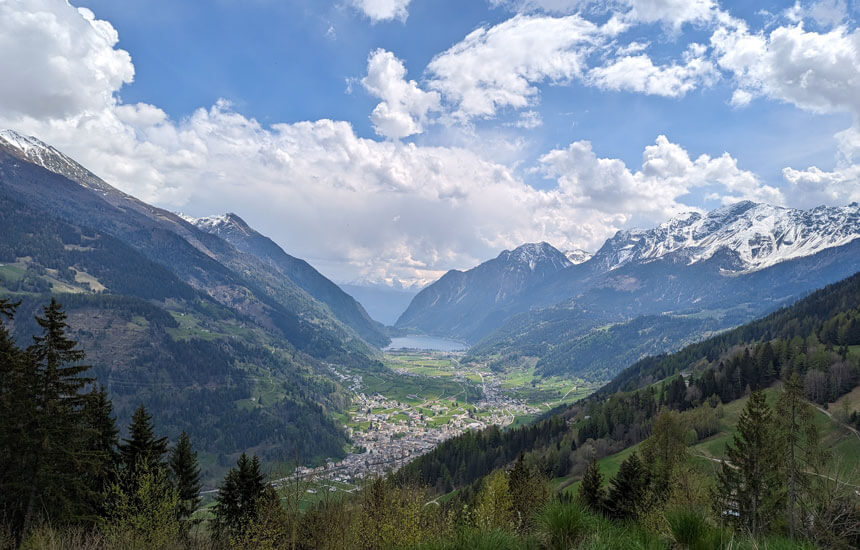
Facts about the Bernina Line
- 38 miles long
- Opened between 1908 and 1910
- Lowest point is 429m above sea level at Tirano
- Highest point is 2253m at Ospizio Bernina
- 16 tunnels
- 52 bridges and viaducts
Taking the Bernina Express vs regional trains
The Bernina Express scenic train and the local scheduled trains run on the same tracks, to and from the same places and past the same landmarks. There are a few key differences though:
| Bernina Express | Regional train | |
|---|---|---|
| Reservation needed? | Yes, book as far in advance as you can | No |
| Can use a travel pass?* | Yes, but you’ll have to pay an extra reservation fee | Yes |
| Classes available | 1st, 2nd | 1st, 2nd |
| Food on board | Yes, an at-seat bar service with light menu of local specialities | There may be a trolley service |
| Non-stop | Yes | No – you’ll need to change at least once, unless you catch the local train which pulls the Bernina Express – look for PE on timetables |
| Panoramic windows | Yes | No |
| Opening windows for photography | No | Yes |
| Can hop off and on | Yes, but the rest of your journey would be on a regular train | Yes |
| Trains per day (Chur to Tirano) | One each way in winter, two each way in summer | 21 per day in summer – roughly one an hour between 5am and 7pm |
The Bernina Express panoramic train is best for:
- getting the full Bernina Express experience
- being able to have food and drink served to you on the journey
- a group travel experience – everyone on the train is there for the same reason
- the feel of a guided tour
- a round trip including Lugano
The regional train is best for:
- the cheapest way to travel the route
- flexibility
- taking photos
- fewer people
- a clean, comfortable but more basic experience
Tips for the Bernina Express
Book your seat reservation as early as you possibly can
While you can only buy a ticket for the Bernina Express two months before your trip, seat reservations go on sale much earlier. You can book seat reservations 7 months in advance – and you should book as far ahead as you can.
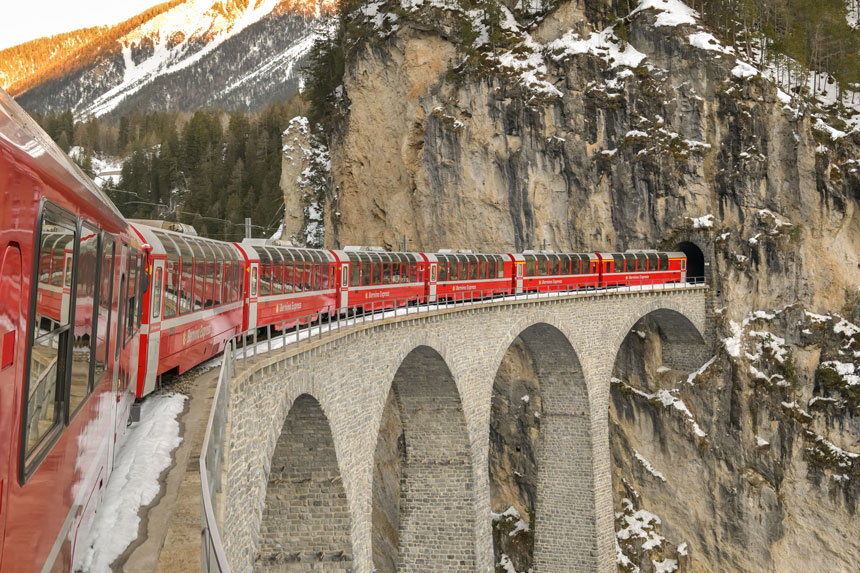
When I searched for Bernina Express tickets, I found seat reservation fees ranging from CHF 10 in December to CHF 26 in July and August for a trip from Chur to Tirano. The trains in the summer were already almost completely sold out, with only a handful of non-window seats left.
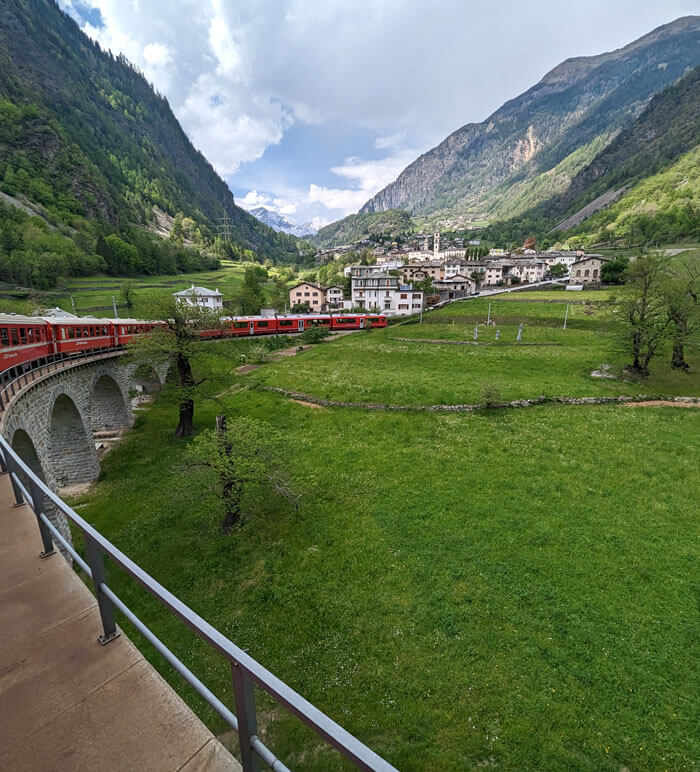
You might need to plan the rest of your holiday around it. but a trip on the Bernina Express between Switzerland and Italy is a once-in-a-lifetime experience. If you’re looking for more flexibility, or if seat reservations are already sold out for your dates, then taking the regular regional train might be a better option for you.
Don’t expect to take great photos from the train windows
The Bernina Express’s panoramic windows are amazing for experiencing the scenery but they’re not so great for photography. The windows by the seats don’t open (although there may be opening windows elsewhere on the train), and create a lot of reflections.
As an example, for the first leg of my journey from Chur to St Moritz on the Albula Line, we were sat in one of the local train’s newer coaches, with big windows that didn’t open. The view was amazing, but when I tried to get a photo of the Landwasser Viaduct, I got a picture with the reflection of my partner’s face hovering above the line.
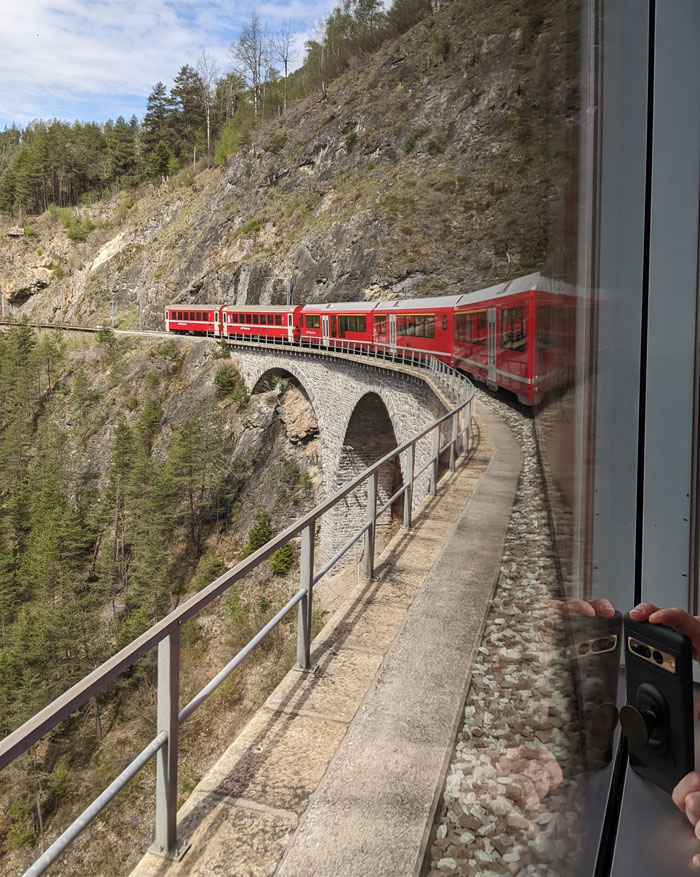
While I haven’t been on the Bernina Express panoramic train myself (you can read about my experience on the local train below), the difficulty with taking photos is something that comes up again and again in reviews of the service. You can see it in YouTubers’ videos on the train; the carriages look amazing but you can see people’s faces and the train lights reflected in the windows.
Tips for taking the regional train from Chur to Tirano on the Albula and Bernina Lines
I used the Rhaetian Railway’s normal, scheduled regional trains for my trip from Chur to St Moritz and then from St Moritz to Tirano in May 2023. Here are my tips if you want to use the regular train rather than travelling on the Bernina Express.
You can use your rail pass
You don’t need a special ticket to travel on the Albula and Bernina Lines. You can use your Interrail or Eurail pass, Swiss Travel Pass or SBB Saver Day Pass. You can also just turn up and buy a ticket at the station or on the SBB Mobile app.
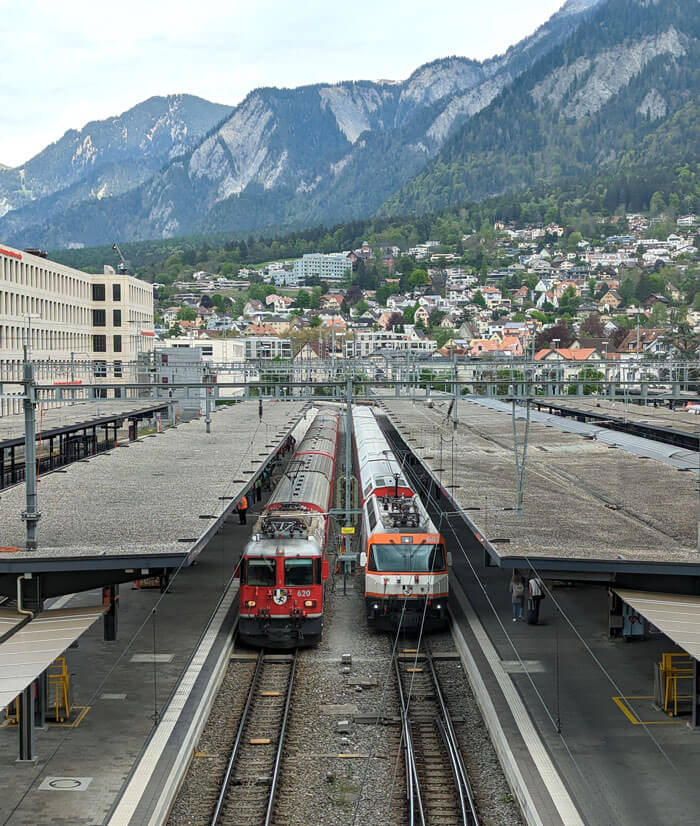
I bought SBB Saver Day Passes for both our days in Switzerland. If you put details of the journey you want to take into the SBB website or app, it’ll tell you whether a single ticket or a pass is a better choice.
For our dates the passes worked out cheaper at CHF 52 each for 2nd class tickets. The passes are valid from midnight on the day you bought them for until 5am the following day, which coming from the UK seems like an absolute bargain.
Our ticket was checked several times during the journey; one of the ticket inspectors also wanted to see our passports.
SBB tickets and passes go on sale 2 months in advance.
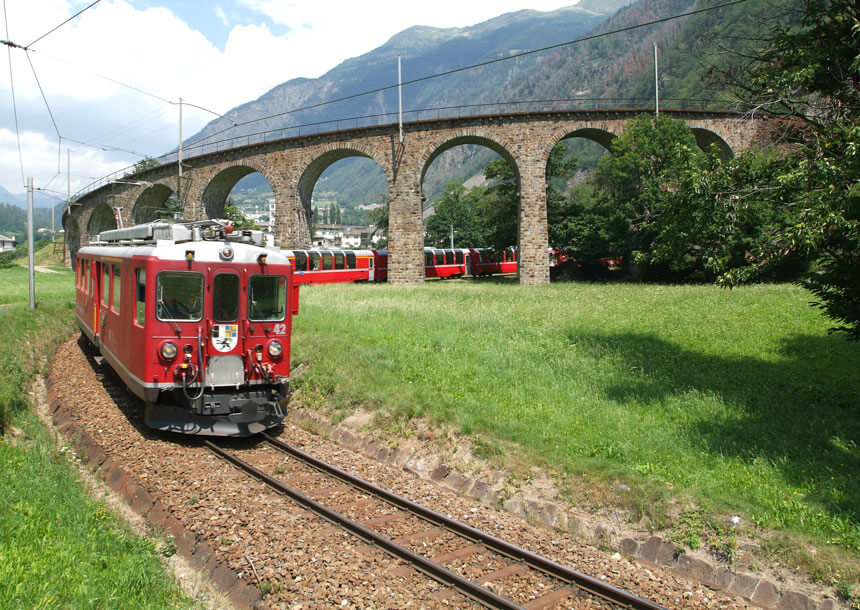
Get to the station early
To make the most of your trip on the Albula and Bernina railways, you’ll want to make sure you get good seats. Neither of the regional trains we took were at all busy, but we travelled in early May, outside school holidays so they may be busier during the summer or when the Alpine ski resorts are in full swing.
Getting to the station early will mean you’ve got the best chance of being able to follow my seat tips for the Bernina Line regional train.
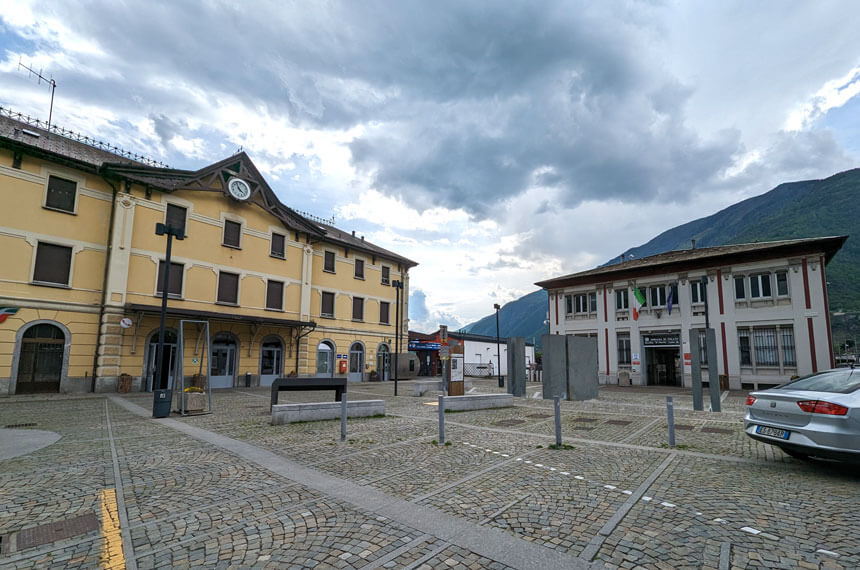
Sit on the right hand side going south, left hand side going north
I’d seen this tip online, but as the train pulled out of Thusis, I was doubting the advice as the right hand side of the train looked out at a rock face while the left hand looked at a magnificent gorge.
A few miles further on, the advice to sit on the right hand side of the train proved absolutely right though. As you approach the Landwasser Viaduct, all the interest is on the right hand side of the train, and only passengers sat on the right will get to see the curve of the viaduct and the beautiful valley below.
As you get into the Bernina Line section of the route, I’d still really recommend sitting on the right hand side. The view of Lago Bianco as the train approaches Ospizio Bernina, the highest point on the pass, was my favourite bit of the day – I couldn’t stop grinning!
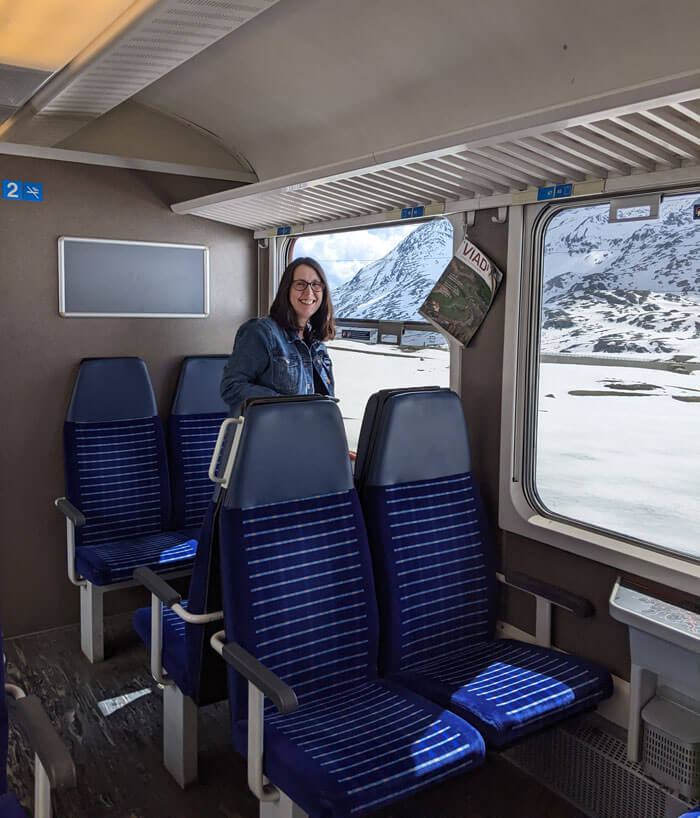
When the route gets closer to Italy, you’ll pass the other major sight on the left hand side of the train, the lovely Lago di Poschiavo. Our train was quiet enough that I could move from side to side so I didn’t miss anything – another benefit of taking the regional train vs the Bernina Express, which is usually sold out.
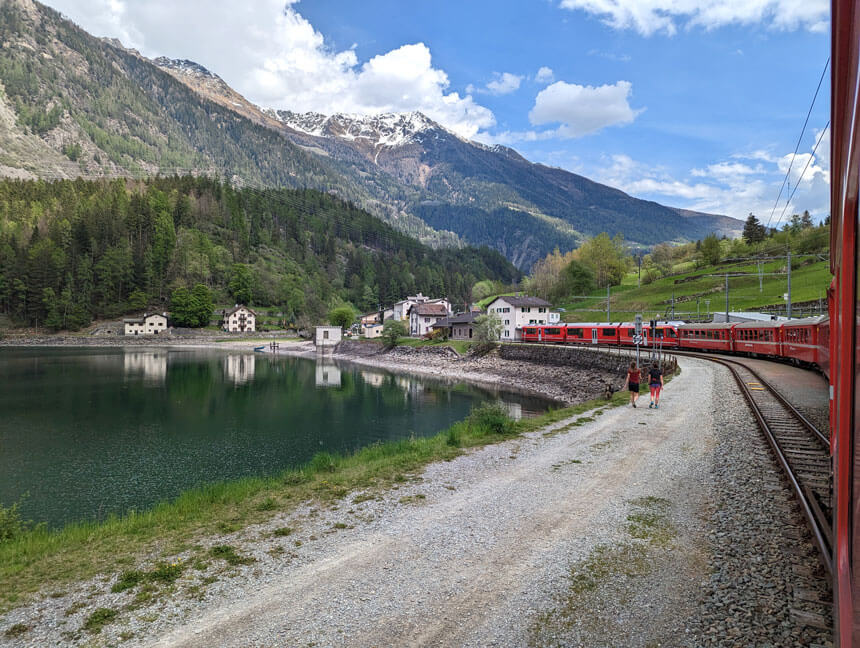
This tip for the best side to sit on the Albula and Bernina Lines is the same for the Bernina Express. Unfortunately, when you book your Bernina Express seat reservations, they can’t tell you what direction the carriage will be facing, which is a bit annoying. Taking the regional train is the only way to (almost) guarantee that you’ll get a good view.
Sit as far back as you can on the train
Even the local trains on the Bernina and Albula Lines are surprisingly long! Sitting in a carriage at the back of the train means you can see the train in front of you as it takes on the railway’s astonishing curves and spirals. It’s a very cool sight!
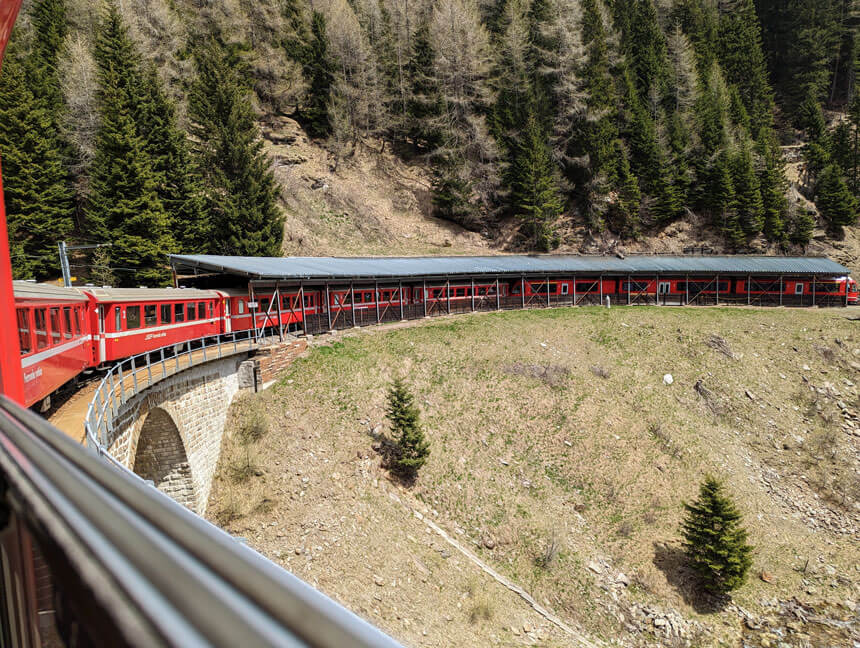
Choose your carriage carefully if you want to take photos
While the regional trains are a much better option than the Bernina Express if you want to take photos of your journey, you’ll still need to choose your carriage and seat carefully. All the seating on the regional trains is unreserved – you just need to have a ticket or rail pass for the class you want to travel in.
There are several types of seating on the regional trains and a mixture of older and newer coaches. All the trains we saw on the way were made up of multiple types of carriage.
First class – newer coaches
There were a couple of first class compartments in the newer part of the train. These carriages have huge windows but unfortunately they don’t open.
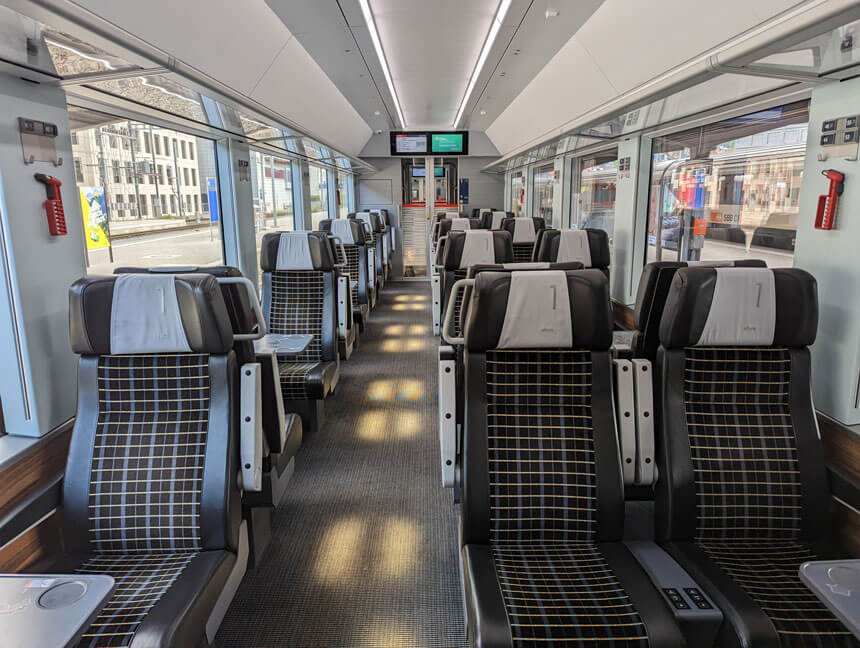
If your train is being pulled by a multiple unit (like the one in the photo below) rather than a locomotive, and you’re travelling in first class, see if you can get seats right at the front. The first set of seats have a window into the driver’s cab; sometimes the driver pulls down the window blind but sometimes they leave it open, giving the passengers behind a thrilling forward view down the line. The train we took from St Moritz to Tirano was arranged like this and sure enough, when we got off at Tirano we saw that the driver had had the blind open.
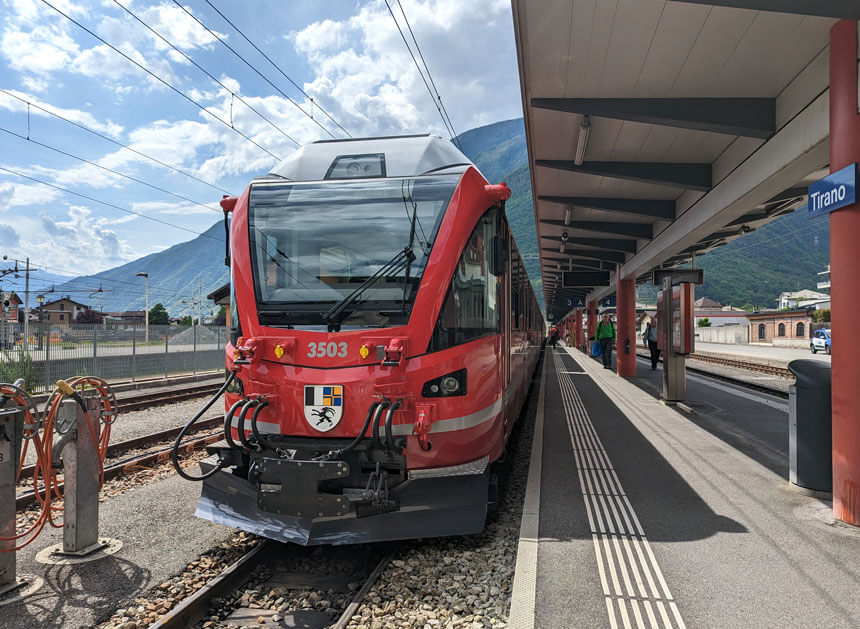
First class – older coaches
These compartments have the same 2+1 seat configuration as the newer ones. The windows are slightly smaller than in the newer coaches, but they do open.
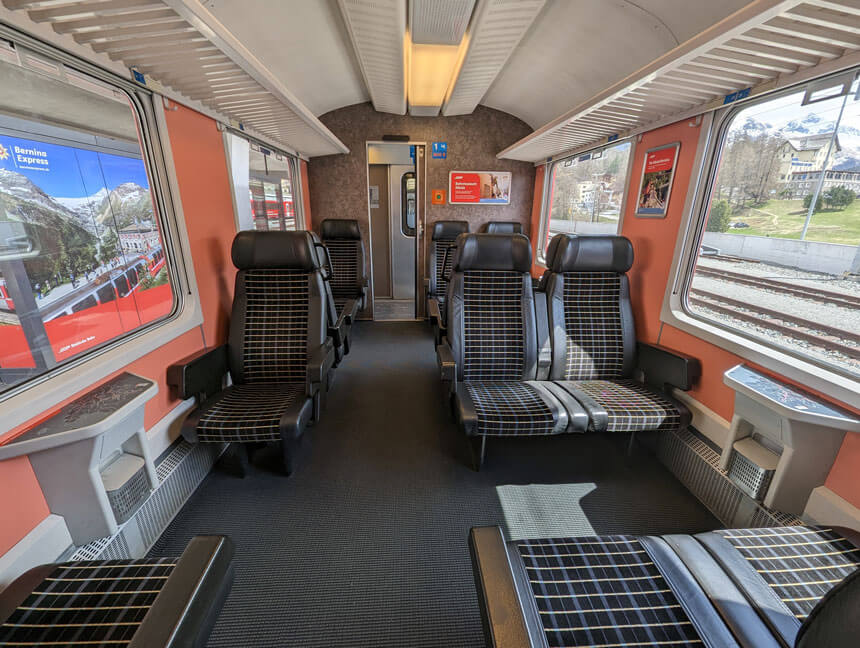
First class seats are wider and more comfortable than second class, but there’s no real difference in service.
Second class – newer coaches
I sat in second class in one of the newer coaches between Chur and St Moritz. The train did have the older style of carriages as well, but we thought that the newer ones with their bigger windows would give us a better view.
We realised going across the Landwasser Viaduct that the older style carriages with opening windows would have been better for taking photos, but one thing I did really like about the newer coaches was the level of information you get about the journey.
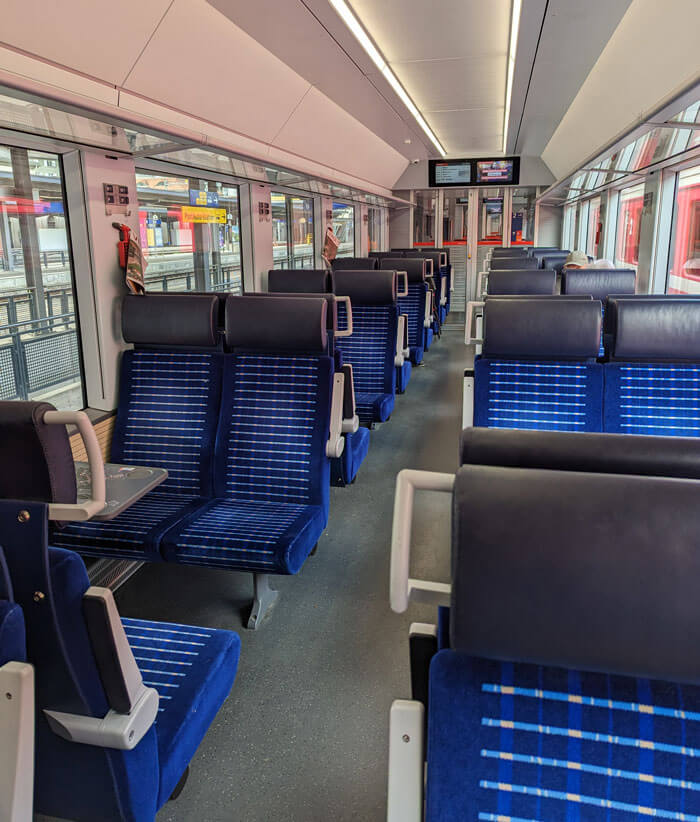
In the newer coaches, there’s a map of the Rhaetian Railways network on the table, labelled with key sights to look out for. There are also announcements made over the train’s PA system when you’re approaching one of the sights, so you don’t miss a thing – for example as we approached the Albula Tunnel there was a short announcement with a little bit of history about the tunnel and some information about the rebuilding project. It’s as close as you can get to the “guided tour” experience of the Bernina Express.
Second class – older coaches
If you’re travelling in second class, there are two big disadvantages of the older coaches vs the newer ones:
- the tables are much smaller and don’t show as much information
- no “guided tour”-style announcements are made in the older coaches
There are also two huge advantages:
- the windows open – making these coaches much better for photographers and people who want to get great pictures for social media
- on both the trains I travelled on, these coaches were at the back of the train, so we got to see the full length of the train going through all the twists and turns on the line
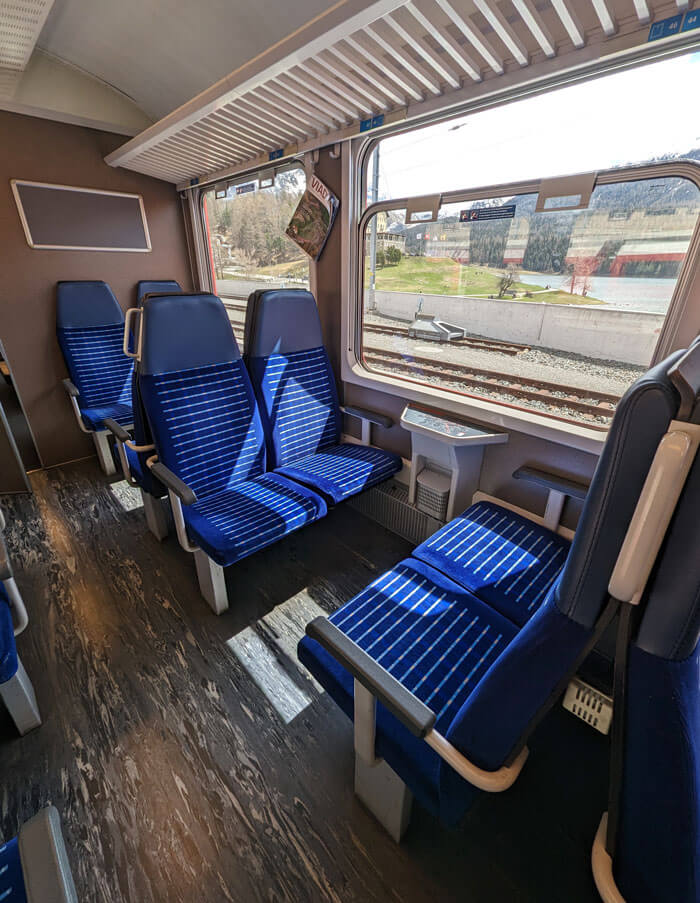
Apart from the windows and the tables, there was very little difference between the newer coaches and the older ones. Both types had comfortable seats, ok but not great leg room and power outlets under the seat.
Photography coach
The trains I travelled on from Chur to St Moritz had a special photography compartment. This second class area was in one of the newer coaches, but unlike normal second class, the windows opened.
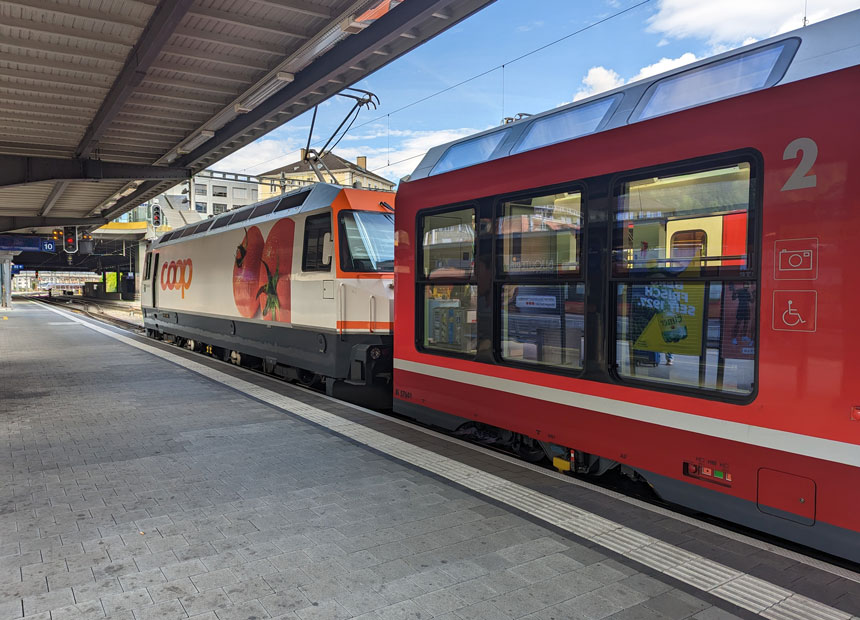
Rather than seats, this section has a central, padded ledge that travellers can rest against. It didn’t look all that comfortable for the full 4+ hour journey. It was also positioned right behind the locomotive pulling our train, so you wouldn’t get a good view of the train itself along the line.
Accessibility coach
This coach, intended for wheelchairs, pushchairs and bikes, had theatre-style dropdown seats around the edge of the compartment and a large open space in the middle.
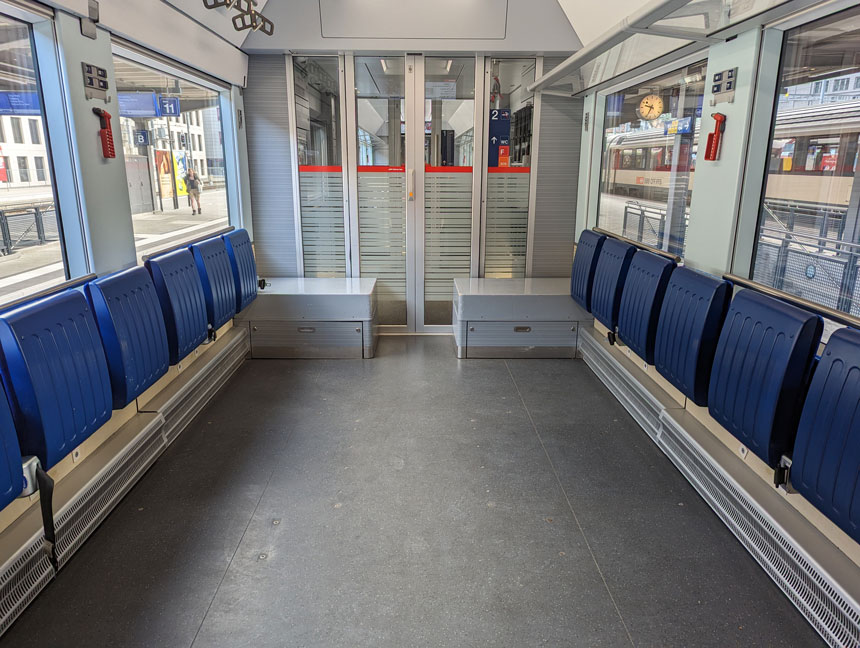
Children’s coach
If you’re travelling with children, then the children’s coach might be a welcome sight. The children’s coach on the Bernina and Albula line trains has activity-friendly tables and a train-shaped slide at one end of the compartment.
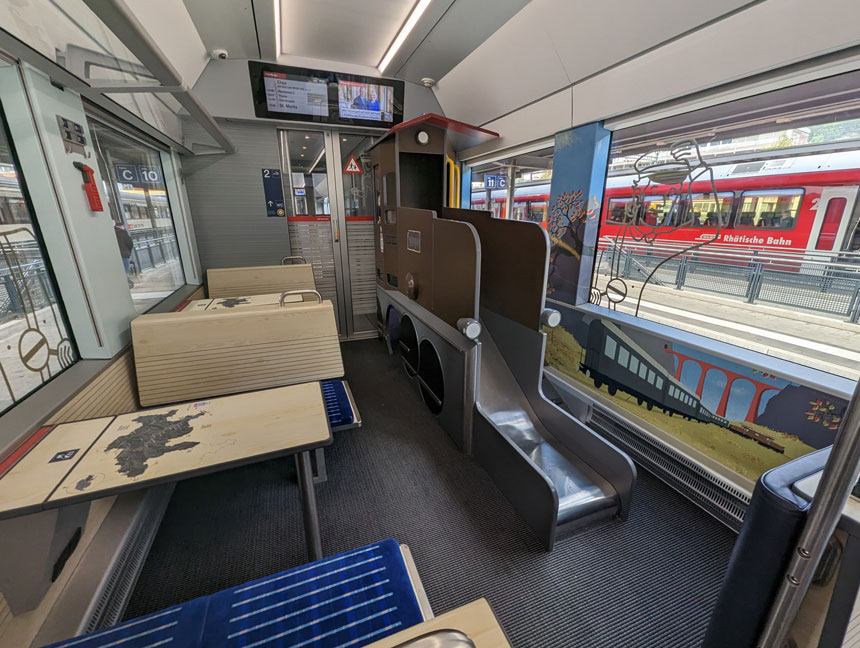
Open carriages
In high summer (usually July and August), you can travel in the ultimate panoramic coach, a completely open air carriage. You might need to wrap up a bit, but experiencing the journey with nothing between you and the scenery would be an amazing adventure.
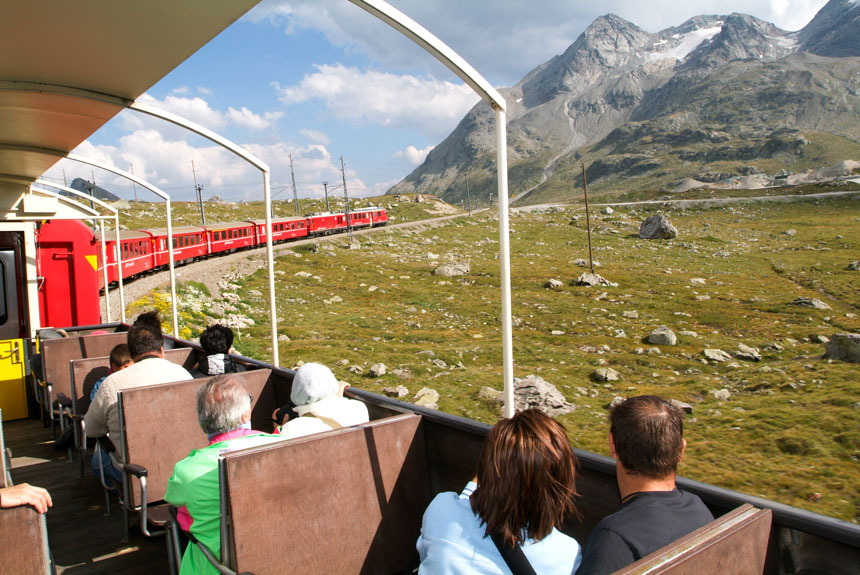
Change at St Moritz
The journey planning websites and apps told us to change at Samedan and again at Pontresina, but it’s worth bearing in mind that they’re trying to show you the fastest journey, not the best experience.
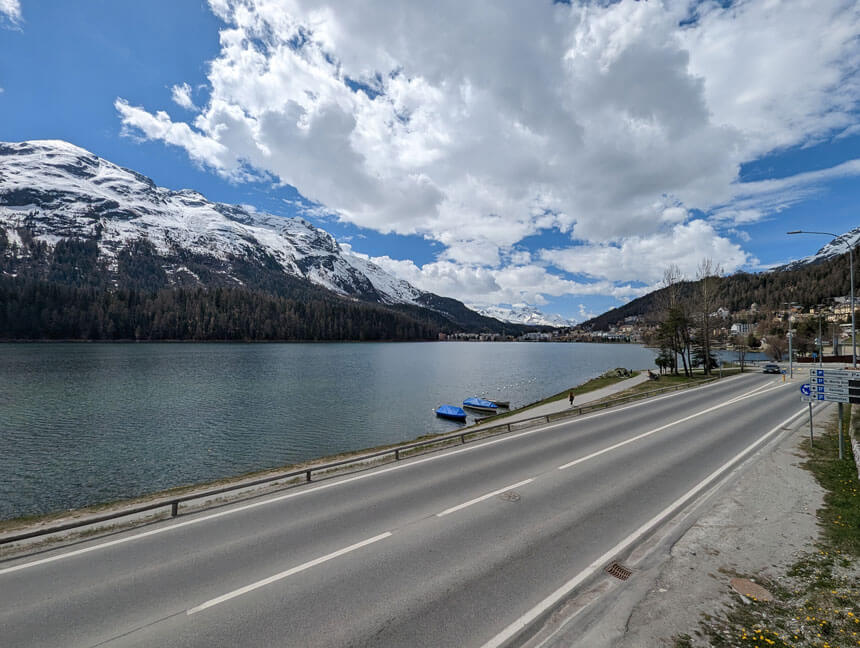
Our train from Chur was going to St Moritz, and the second train started at St Moritz, so we decided to change there instead. This ended up being a great decision; we had around 45 minutes to stretch our legs, have a look at Lake St Moritz, get a sandwich from the convenience store at the station and still be nice and early to get a good seat for the next part of the journey.
Consider breaking up your journey
If you’re travelling on the regional train, why not make the most of the flexibility by breaking up your journey at one of the interesting and beautiful stations en route?
If you have a pass like the Eurail or Interrail pass, or a Swiss Travel Pass or Saver Day Pass, you can hop on and off as much as you like – you could even spread the journey over a few days by staying overnight in one of the towns and villages along the Albula or Bernina Line.
Options for stops along the Albula Line include:
- Filisur, where you can take a 3.5 hour hike to see the Landwasser Viaduct from the valley below
- Bergün, where you can go sledging in the winter or visit the Albula Railway Museum all year round
- St Moritz, where you can explore the legendary town. In summer, you can relax by the lake or enjoy some of the watersports on offer. In winter, you can go skiing or try a bobsled run. From St Moritz you can also take a scenic ride on one of the Rhaetian Railway’s other lines from St Moritz to Davos – also included in your Interrail, Eurail or Swiss railway pass.
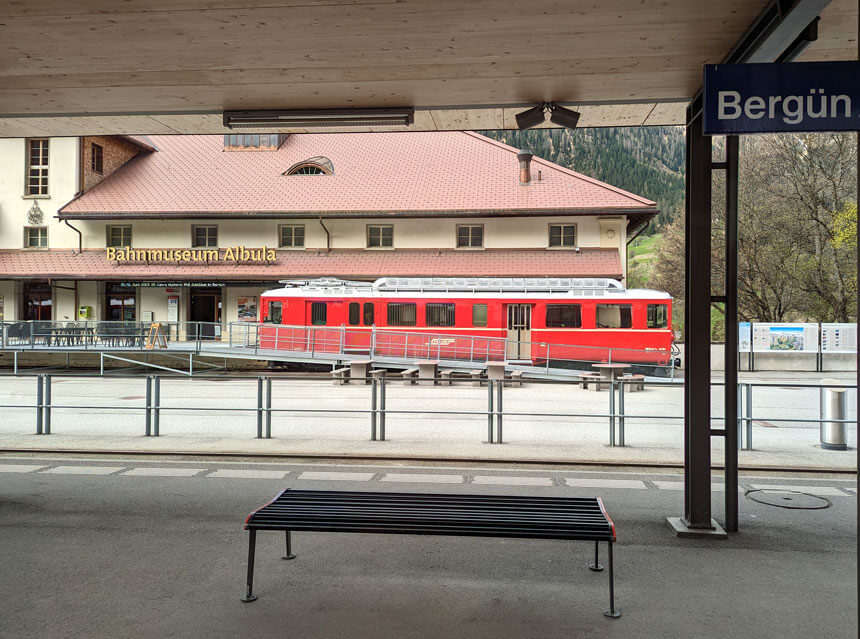
Good places to break up your journey on the Bernina Line include:
- Punt Muragl Staz, where you can take the Muottas-Muragl-Bahn funicular railway up to Muottas Muragl, 2,454m up for amazing views over the Upper Engadine valley
- Pontresina, a picturesque Alpine village with historic houses, elegant Belle Epoque hotels and a family-friendly spa
- Bernina Diavolezza, where you can ride a cable car up to the top of the Diavolezza mountain. When I rode on the Bernina railway in early May 2023 there were still skiers and snowboarders on the mountain slopes at Bernina Diavolezza.
- Alp Grüm, where there are great views of the Palü Glacier and Lago Palu from the station platform. There’s a restaurant and hotel in the station building so Alp Grüm could be a good place to stop for lunch – it was my original plan but both the hotel and restaurant were closed until the week after my visit.
- Poschiavo, which is still in Switzerland but feels very Italian with grand palazzos
- Miralago, on the banks of the beautiful Lago di Poschiavo
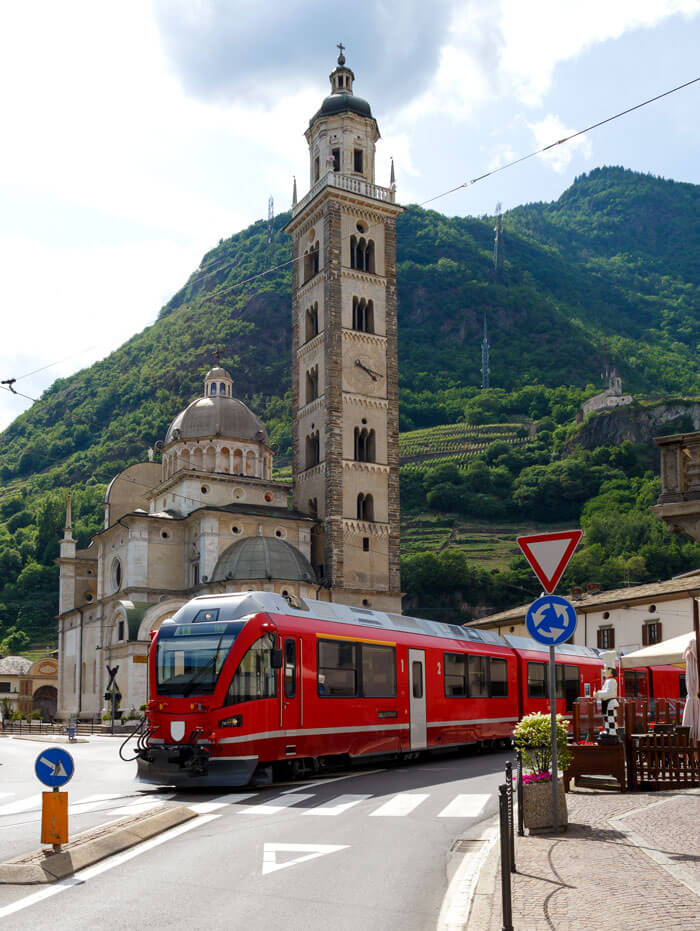
Buy a guidebook
Since the local train doesn’t include the same level of on-board information as the panoramic train, we bought a guidebook from the SBB shop at Chur station. It cost CHF 15 but the information inside and route maps was really interesting and useful – and still less than the cost of a Bernina Express reservation.
Upgrade to 1st class if you need to
Both of our trains were quiet enough for us to get the seats we wanted and to be able to move across the carriage when the view was on the other side.
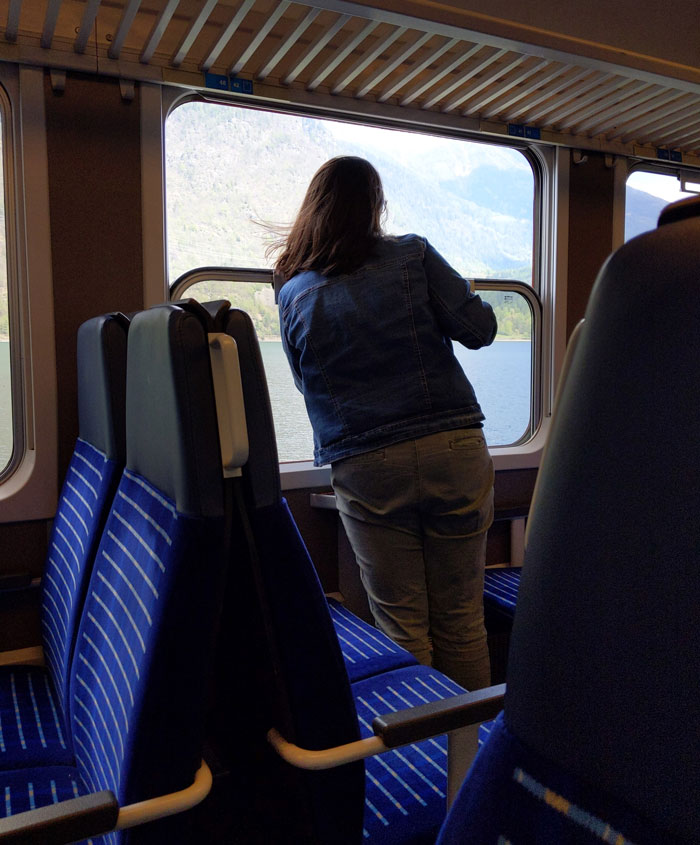
Since we were using tickets in the SBB Mobile app, if we had found that second class was too busy to get a good view, we would have used the app to buy a point to point first class upgrade for a section of the journey. To give you an idea of prices, a point to point first class update for St Moritz to Tirano would have cost us around CHF 23 each.
Take drinks and snacks
There was a trolley service for drinks and light snacks on our train from Chur to St Moritz, but no catering at all on the train from St Moritz to Tirano. At Chur, there are a few shops and bakeries on the concourse that runs between the platforms.
At St Moritz there’s a convenience store right on the platform which sells surprisingly decent sandwiches and also has a small bakery and coffee machine.
Is the Bernina Express worth it?
Travelling along the route of the Bernina Express is absolutely worth it, but which type of train you should take will depend on what you want to get out of it.
The regional red trains were the best choice for me because it gave us flexibility, I wanted to be able to take photos and the normal carriages were clean and comfortable.
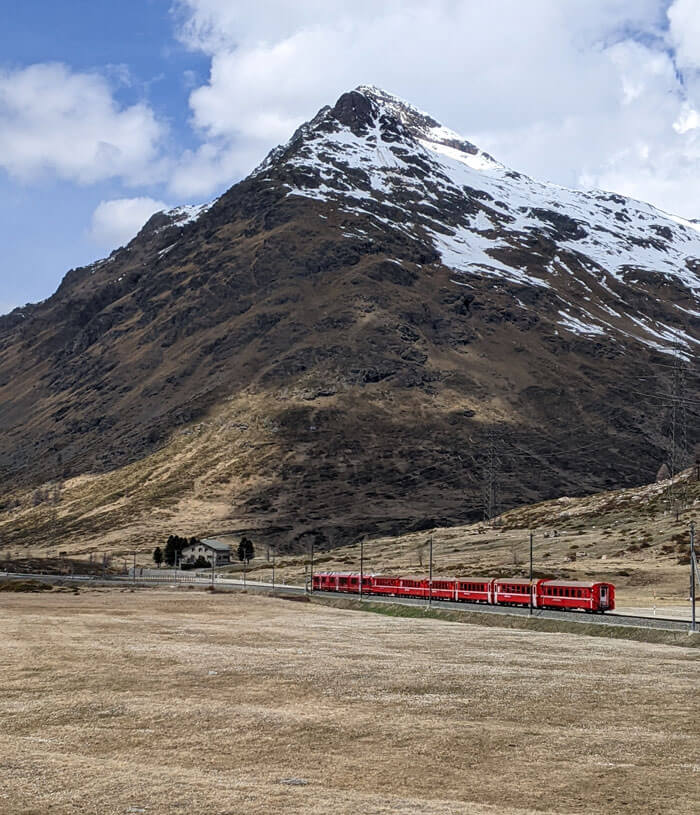
If you want the full Bernina Express experience, and to feel immersed in the landscape along with other people who are there for the same reason, then the panoramic train may be worth it for you.
I hope you’ve found this guide to the Bernina Express useful. If you have, you might like my post about where to stay for a trip on the Bernina line.

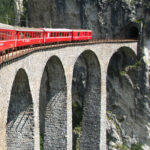
Thank you SO much for this extremely helpful blog I really appreciate the effort and time you spent in sharing all this useful information 🙂
You’re very welcome Amy, I hope it helps!
Helen – love this site, so much useful information but am slightly confused.
Could we take the Bernina Red train from Chur to St. Moritz and stay overnight? Then get back on the train from St. Moritz to Tirano, Italy?
Hi Tina, thanks for your message. Yes you can get on or off at any point if you buy a day pass, no reservations needed for the red trains. The only issue with staying overnight in St Moritz would be that you’d need to buy another ticket to travel on to Tirano. Hope that helps and I hope you have a wonderful trip.
how do I book the Bernina Express bus?
Hi Shruti, you can buy the bus ticket as part of your Bernina Express reservation on https://shop.rhb.ch/en/bernina-express.
Hi, Thanks for your information, is there much of a price difference between the red train and the express.
I am going on to Zurich from Chur the same day, is there a travel pass you can use for the red train and Zurich train, thanks
Hi Graham, it depends – if you want to sit in a panoramic car then you need to buy a special seat reservation on top of the normal fare.
The Bernina Express panoramic cars are actually just part of a normal service on the route (it pulls a regular red train at the back, which anyone with a ticket can sit in). If you buy a day pass, you can sit in the normal red train cars, get on and off as you want, and it’ll cover the journey from Chur to Zurich as well. Hope that helps!
Thank you so much! This was all so useful. We were thinking we’d take our 3 little children on the Bernina Express this summer (two train loving little boys) but even with kids travel free it was going to be £400 for a same day return and that was really not in the budget!! But the option to do the regional train with the same views sounds perfect (and only £80). And actually it’s probably better for the kids with more train times and maybe even a slide. My question… We’re going to get on the train in Tirano and travel back the same day. Do you have any suggestions for where we should change to come back? I was thinking maybe Alp Grum as I wonder if St Moritz would be too far. But is it worth doing the extra time on the train? Will we be missing out if we don’t go the whole way?! Really appreciate any advice.
Hi Liz, if you can, I’d go a little bit further as the section around Ospizio Bernina is really stunning – there might not be as much snow as I saw in May but it’s the highest point on the line.
Pontresina might be a good compromise as it’s a little closer than St Moritz, feels Swiss rather than Italian, has some walks to stretch your legs and has places to get something to eat. There’s better info on the area website https://www.pontresina.ch/en. The train to Pontresina will take just over 2 hours.
If you use the Rhaetian Railway website to check train times you can see if there’s a family coach – they’re marked FA. The Rhaetian Railway website is https://tickets.rhb.ch/
Hi Helen
Most useful article thank you very much. I am looking at doing the Tirano to Chur (and then onto Zurich) route in a couple of weeks and I think regional red line is the best option (as Bernina Express only running in the afternoon). I see that you only had to make the one change in St Moritz, however when I use the SBB site it seems to suggest I will need to make multiple changes (Pontresina and Samedan) – which is fine but fewer changes would be better. Did you find it was possible on the day to just work out the timings to take the train to St Moritz and then on to Chur?
Also, do you recall what the luggage storage was like on the regional red line? My father will likely have a medium/large sized suitcase with him and Im not sure if that renders the trip unfeasible?
Many thanks
Emily (New Zealand)
Hi Emily, thanks for your comment!
The SBB site is trying to give you the fastest route (which is with two changes at Pontresina and Samedan). In effect there’s a triangle of railway lines between Pontresina, Samedan and St Moritz and the SBB site is cutting off the St Moritz corner, which makes the journey a little quicker. I wasn’t in a rush and wanted to see the lake in St Moritz so I went all the way to the end of both lines, rather than cutting off the corner. What I did was look on the SBB site twice, once for a train from Chur to St Moritz, and another from St Moritz to Tirano, so you’d just do the same in reverse. Hope that makes sense!
I spoke to someone from the Rhaetian Railway about luggage, and they said that there is luggage storage on the regional trains, but there’s almost always plenty of space on the train to keep it with you. If the train is unusually busy then you could perhaps look at upgrading to first class which has more space, but I think your father will be fine with his suitcase.
Hope you have an amazing trip!
Hi Helen…I’m so happy I found your blog! I, like you, am crazy for travel. I’m coming from Greece on June 9th to Milan and will take the train to Tirano from Malpensa, spend the night, hopefully at one of the two places you recommend, then take the train the next day. I was convinced to do 1st class on the Express but now I think I’ll take the regional trains. I was planning on spending the night in Chur and continuing to Zurich the next day to fly back to the US or spend an extra night in Zurich. Now, Im wondering if I start around 9 AM can I go all the way to St Moritz, then head to Zurich the same day? Would you buy a 3 day rail pass? Can you recommend a good hop off stop for lunch on the way to St Moritz. Im really lost in the maze of ticketing for sure! Thanks so much for any information.
Hi Cher, glad you found it helpful! You can definitely get from Tirano to Zurich in one day, it’s less than 6 hours on the train so there’s plenty of time to stop off en route. I checked the SBB.ch website (Swiss National Railways) and that suggested a route starting at 9am, changing in St Moritz and Landquart and you’d arrive in Zurich just after 3pm. One watch out on the SBB site is that the default is for prices to be shown including the Swiss Half Fare railcard as so many Swiss people hold it. If you go through to book, there’s an option to remove the the half fare discount.
For that route, right now the cheapest ticket is a supersaver ticket at 80 CHF but I’d recommend the Saver Day Pass at 88 CHF which will give you a lot more flexibility. It’s valid for train trips pretty much anywhere in Switzerland for a whole day and it’s what we used on both days we travelled by train in Switzerland. You could either stop off in St Moritz when you change trains, or in Chur which is surprisingly charming – we had traditional rosti at Restaurant Ratushof which is only a few minutes’ walk from the station and on the edge of the historic part of town.
Another option if you have a bit more time might be to change trains at Landquart for Zurich and get off at the next stop Sargans, from where you can get a bus or taxi to Vaduz which is the capital of Liechtenstein – so you could tick off a third country in one day! There isn’t an awful lot to see but you can get a special stamp in your passport and take a little tourist train around the main sights.
Hope this helps! I hope you have an amazing trip 🙂
Hi! Thanks, Helen for all the information. I’m doing the train journey from Milan for the day, so it will be Milan- Tirano – St. Moritz – Tirano -Milan. How much time do you need to get from one train to another? How easy is it to find where to take the following train? I assume your advice of doing everything on local trains is good in this case since it will give me more flexibility to catch the next train without being nervous of missing it.
Hi Albertina, honestly it’s so easy.
In Tirano you’ll need to come out of the Trenord station and walk across the square to the Bernina line train station, it’s on the left hand side of the square. It’s a small terminus station so you can’t go wrong, almost every train will be going to St Moritz with the exception of the actual Bernina Express train to Chur (that one misses out St Moritz).
St Moritz is a relatively small station with only 6-ish platforms, all right next to each other. It’s also a terminus station so all the platforms are joined together at the end. It’s easy to get between them, there’s no underground passageway or bridge or anything. Everything is really clearly marked with clear platform numbers and destination boards. No need to worry! And yes if you use the local trains it doesn’t matter if you miss one or if you want to stay somewhere a bit longer.
Hope you have a wonderful trip!
Thank you Helen for all this information. I understand that the regional trains will take you to Tirano. Can you take regional trains from St. Moritz to Zermatt? Thank you for your insight.
Hi Trena, I hope it was helpful! Yes you can, there are a lot more changes involved than the Bernina and Albula routes but the Glacier Express route is still just a normal railway line with local trains too.
The rail planning websites will tell you to go round by Zurich but you can get from St Moritz to Zermatt changing at Reichenau-Tamins, Disentis/Mustér, Brig and Visp. It’s a long day though!
Hi this is the best information I have found so Thankyou
We are taking local train from Tirano to St Moritz then staying overnight before catching train to Zurich the next day
I feel taking the local train is far less stressful as there is no set time and they go so regular so if you miss one just wait for the next
Can’t wait
Thanks
Thank you! Yes I really liked the flexibility of the local trains. I hope you have a wonderful time, I wish I’d had a bit more time in St Moritz!
Hello from Canada! We are doing the Tirano to St. Moritz and back in Aug 2024, I was wondering if you could help me with the differences between the first class and second class NOT on the Express, but on the regular train. Our plan is to be on the 741am train in Tirano, and come back in the late afternoon. so what would be the best reason to pay the almost double cost for 1st class over 2nd class?
Hi Keith! In all honesty there’s not much of a difference. The first class carriages on the regular train have wider seats and there are fewer of them, with two seats on one side of the aisle and one on the other. There’s also more legroom, but I was in second class and I didn’t find it cramped or crowded at all. The seats in second class were comfortable enough for me, there were more empty seats than occupied ones and there’s no difference in service between first and second class on the regional trains.
You could always buy the second class ticket and then if your train is particularly busy you could buy a first class upgrade?
There are a few pictures of each type of carriage about halfway down the article, search for First class – newer coaches if you’re having trouble finding them. Hope this helps!
I’m thinking regional. Buying the guidebook is great info! Great ideas. Thanks. I’m planning on returning the same day as well. We’re staying in Bellagio. Is there a different route u could take back? We love villages.
Hi Jackie, you could, in theory, take the Bernina line to Chur, then the train on to Zurich and come back via the Gotthard tunnel and Lugano, but I’m not 100% confident that you’d be back in time to get the ferry back over to Bellagio as they don’t run all night.
You could perhaps do the loop to Davos or the Arosa line from Chur, which are both meant to be very beautiful. Alternatively if you love villages, you might want to stop off along the Bernina and Albula route to explore some of the places along the way?
Can’t thank you enough Helen!! Your very fine work takes a lot of vacation planning pressure off of me. With appreciation, Deirdre in Florida USA
Thank you so much Deirdre, I’m glad it helped!
Really useful. We are staying in Bellagio – and want to get I think the regional train to St.Moritz. So where would we get that from (Tirano??) and would we need to change? It’s hard to find clear information!
Hi Sarah, from Bellagio you’d get the ferry over to Varenna (the station name is Varenna Esino) and take the Trenord train to from there to Tirano. At Tirano, walk literally across the street to the Bernina line station and almost any train from there will be going to St Moritz with no need to change.
The only exception is if the train is the one pulling the Bernina Express to Chur (there are normal regional coaches on that one too) as some of those miss out St Moritz. If you catch that one then you’ll need to change at one of the stations along the line; Alp Grüm could be a good one as there’s a cafe there during the summer months and there’s fantastic views of the railway line curving away down the hill and of the glacier.
Hope this helps!
Hi Helen, We’re doing Oktoberfest this year and my son & GF have a couple of extra days before flying out of Milan. I really thought I had messed up the Bernina Express for them from Chur, Switzerland to Tirano, Italy. Reservations are full for the day they needed to travel. Your article was the BEST!! Thank you so much. They will have a wonderful time and I’m relieved that those reservations are not a ‘must’. Can’t thank you enough for your help. Happy travels! Maybe will see you in Munich?!? It’ll be fun. We have been before…3 others have not! Going to love showing them around. Thanks again! Lisa, Indianapolis, Indiana, USA
Hi Lisa, I’m so glad to have put your mind at rest! I thought I’d made the same mistake before we travelled but I think we had a better time on the local trains. Hope you enjoy Oktoberfest and you all have an amazing vacation!
Thankyou. This is such helpful information. I’m planning to take this journey in early October and after reading of your experience and others I think I’ll take the regional train. I’m planning to stay overnight in Chur and travel the next day.
Thanks again
Maureen from Australia
Thanks Maureen! I hope you have a wonderful trip, Chur is a great place for a one-night stay.